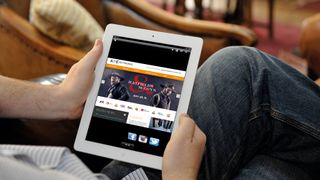
Here's a vision of the future. You turn on your TV and by the time you've found your tablet computer and sat down, the big screen has booted up. On the flat, glossy wall-mounted display you can see recommendations of programs the TV knows you'll like.
You select one and look at your tablet. It's running an app that accompanies the show and it's filled with your friends' comments and catcalls. The show's presenter asks for comments, and you tweet in. Your message appears on TV.
After the show you keep chatting with the presenter and your friends. This isn't a TV executive's daydream - it's here, now. It's called social television and it's heading to screens near you.
TV watching used to be a passive business. You'd find your show in Radio Times, make sure you were sat down at the right time, and watch from beginning to end. And that was it until next week. Today this seems rather Neanderthal.
As we've seen in our guide to FreeGuide, there's no need to make an appointment with your TV; you can watch what you want, when you want.
Getting social
TV's evolution is taking it into different dimensions, too. The American show Oprah's Lifeclass illustrates what social TV is all about. Currently in its second series, the programme features inspirational speakers discussing challenges they've faced in their lives.
As the show unfolds, Oprah Winfrey asks viewers to tweet in. The tweets, edited and sifted by a backstage team, appear on big screens behind her. Viewers can Skype in and supply Instagram images.
Get daily insight, inspiration and deals in your inbox
Get the hottest deals available in your inbox plus news, reviews, opinion, analysis and more from the TechRadar team.
The show embraces Facebook too. It seems hooked into just about every communication conduit, pulling in viewers' opinions and excitement. During ad breaks, the second screen shows the backstage team working. The camera never stops.
Social TV goes deeper than just throwing up a poster for your show on Facebook and asking fans to like it. Gareth Capon, product development manager (emerging product group) at Sky explained that the movement taps into something much deeper.
He said people crave a personal relationship with the content. They want to get closer to the stars, the action and the story, and that's just what the two-screen social TV experience lets them do. Capon explained his vision of how a show begins to exist "beyond the TV schedule". The program itself is just one part of a long timeline.
Feuds and fans
This idea is demonstrated brilliantly by the US History Channel. Its series Hatfields and McCoys tells the story of two legendary feuding families from 19th century West Virginia. A&E Television networks, History Channel's owner, explained: "[The show] is the story of a clash of clans that evoked great passion, vengeance, courage, sacrifice, crimes and accusations, and includes a cast of characters that changed the families and history of the region forever."
The three-part show's success has been phenomenal. According to A&E, "Among total viewers, part one and part two now rank as the number one and number two entertainment telecasts of all time in ad-supported cable."
The show is surrounded by a huge social drive to pull in viewers. Feuds are a central theme; viewers are asked to make their allegiances known by following the #Hatfields or #McCoys hashtags. There's also a Facebook app that helps viewers work out which side they belong to.
The show and its social media integration have been so successful that reality TV producers are now reportedly looking for descendants of the legendary clans, and tour companies are offering history buffs the chance to visit the sites where the families lived and feuded.
Making news

On this side of the Atlantic, the desire for viewer participation reached a crescendo during the 2011 London riots. Gareth Capon explained that Sky News had "millions of journalists" on the ground as viewers submitted stories and opinions "People wanted to engage with the newsroom," he said. "The London riots allowed for great insight and great coverage."
Most Popular

